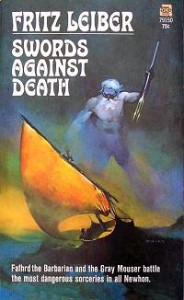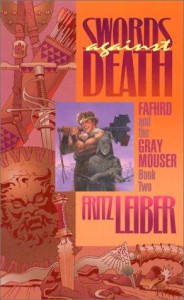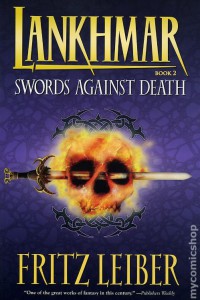Swords Against Death Re-Read: “Claws from the Night”
 Bill Ward and I are re-reading a book from Fritz Leiber’s famous Lankhmar series, Swords Against Death. We hope you’ll pick up a copy and join us. This week we tackled the eighth tale in the volume, “Claws from The Night.”
Bill Ward and I are re-reading a book from Fritz Leiber’s famous Lankhmar series, Swords Against Death. We hope you’ll pick up a copy and join us. This week we tackled the eighth tale in the volume, “Claws from The Night.”
 Howard: Despite some fine moments, I thought this one more fair than fabulous. It didn’t come close to the heights of last week’s tale, “The Seven Black Priests.” This is the first one I remembered as being stronger than it turned out to be on revisiting. On the plus side, there’s a creepy tower and some menacing birds, but perhaps the finest moments are earlier on, when we glimpse how Fafhrd and the Mouser are perceived by the landlord, and the moment when Fafhrd reacts when their bird dies. I also like the comments on Lankhmar fashion throughout.
Howard: Despite some fine moments, I thought this one more fair than fabulous. It didn’t come close to the heights of last week’s tale, “The Seven Black Priests.” This is the first one I remembered as being stronger than it turned out to be on revisiting. On the plus side, there’s a creepy tower and some menacing birds, but perhaps the finest moments are earlier on, when we glimpse how Fafhrd and the Mouser are perceived by the landlord, and the moment when Fafhrd reacts when their bird dies. I also like the comments on Lankhmar fashion throughout.
Bill: Those were probably my favorite moments as well. Particularly the landlord remarking on the “two honest rogues” as they marched off with a fishing pole and something wriggling under Fafhrd’s cloak (I’m not sure what could look more suspicious!). It seemed to me Leiber was then setting up the description of the mysterious thefts and attacks to perhaps make it seem the work of our heroes, though he quickly dispels that. I cannot recall if I suspected Atya as being behind it the first time I read it (hard not to, as she has pet birds). Mouser’s giggling as he listens to Atya dressing down her miserable husband is another great character touch.
 Howard: I agree — that was probably the best moment of Atya’s nagging scene. Her long monologue isn’t half as interesting as the villain’s monologue in “The Howling Tower.” It feels twice as long as necessary and then there’s ANOTHER monologue while Fafhrd is literally a captive audience, explaining everything about Atya’s story. Once Fafhrd turns the tables on her the suspense is over, except for the moment when each of the birds steals the treasure and flies away. I didn’t get the sense Leiber felt like bringing this one to complete fruition, or giving us a thrilling combat scene. Despite its length, the interesting stuff is over fairly quickly.
Howard: I agree — that was probably the best moment of Atya’s nagging scene. Her long monologue isn’t half as interesting as the villain’s monologue in “The Howling Tower.” It feels twice as long as necessary and then there’s ANOTHER monologue while Fafhrd is literally a captive audience, explaining everything about Atya’s story. Once Fafhrd turns the tables on her the suspense is over, except for the moment when each of the birds steals the treasure and flies away. I didn’t get the sense Leiber felt like bringing this one to complete fruition, or giving us a thrilling combat scene. Despite its length, the interesting stuff is over fairly quickly.
It works, but it doesn’t thrill.
Bill: The elements were there. I would have liked to have seen perhaps a little more done with the thieves who were rivals for the bird’s treasure. I felt they could have been integrated into the plot a bit more, as direct rivals that F&GM had to foil. “Tyaa” is a great name for a bird deity, and I like Leiber giving us yet another odd god (and cleverly letting the birds rob our heroes of their treasure). The image we’re left with near the end, of Atya possibly turning into a bird and escaping, was done very nicely I thought, with the Mouser not really wanting to believe what he thought he saw. Overall, as you say, it works just fine, but it is not a first rank F&GM story — although it does give us a lot of the elements we want in these stories. If I wasn’t reviewing, I’d probably be less critical, but I do think there is a good reason I completely forgot this story after 7 years or so, whereas many of the others in this book are instantly familiar (even if I don’t recall the plot or climax).
Howard: We’re nearing the end of the collection. Next up is “The Price of Pain-Ease.” Unlike every other tale in the collection, I have no strong recollection of it. Will it be a hidden gem or a filler? I look forward to finding out. Hope to see you here.

10 Comments